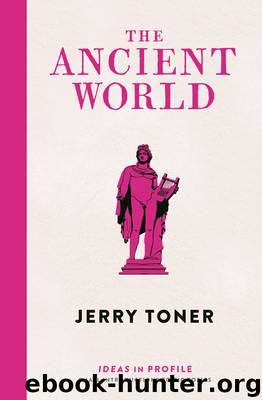The Ancient World by Jerry Toner

Author:Jerry Toner
Language: eng
Format: epub
Publisher: Profile Books
A mosaic of a skeleton from Pompeii
Many of the bodies from both towns display what is called the ‘pugilistic’ position: that is they have their arms stuck out like a boxer. This is characteristic of a body that has been exposed to very high heat at death. What the bodies from the two towns are saying is that it was the super-hot pyroclastic surges from the volcano that were the real killers, not the ash. Rather than being slowly suffocated, most victims were killed instantly by exposure to surges that reached 250 degrees Celsius in Pompeii and 400 degrees in Herculaneum. There was nowhere for them to hide. The fact that bodies have additionally been discovered under roofing material and walls suggests that some will have been killed by the buildings they were sheltering in collapsing under the weight of the falling ash.
The bones challenge modern assumptions that it would be young, healthy males who were most likely to survive the disaster. In Herculaneum, the bodies found by the beach show a strong bias in favour of women and young children. But in Pompeii there seems to be a roughly even number of men and women among the victims. What is most noticeable in the more recent Herculaneum finds is that the men died on the beach, presumably in a desperate attempt to launch boats out onto the sea, while the women and children sat huddled together under the brick arches that ran along the shoreline.
The lack of any obvious bias in the adult victims in Pompeii by way of age or sex may be because the final volcanic surges happened with such speed that there would have been no chance for anyone to escape no matter how fit or strong. But what we don’t know is what percentage of the population died in the disaster. About 1,100 bodies have been found in Pompeii, while estimates for the size of the population range from six thousand to thirty thousand. Either way, a considerable majority of Pompeians have not been found. They might all have left the town in the days, months and even years before. The eruption had been brewing for some time, with tremors being felt, so perhaps most people had already left. And there had been a major earthquake in 62 AD, which may have meant many had already abandoned the town. Or perhaps their bodies are still lying in the ash, waiting to be discovered as they were in Herculaneum.
The bones can tell us something about the level of health in the population. Teeth are particularly useful in this respect. Dental hygiene was almost non-existent in the ancient world but then sugar was much less widely used. A sample of the victims’ jaws in Pompeii showed that well over half had lost a tooth when they were alive. One upper jaw had lost no fewer than fourteen teeth. This tooth loss might have been the result of decay or simply old age. The incidence of caries was
Download
This site does not store any files on its server. We only index and link to content provided by other sites. Please contact the content providers to delete copyright contents if any and email us, we'll remove relevant links or contents immediately.
The Gnostic Gospels by Pagels Elaine(2041)
Devil, The by Almond Philip C(1910)
Jesus by Paul Johnson(1895)
The Nativity by Geza Vermes(1855)
The Psychedelic Gospels: The Secret History of Hallucinogens in Christianity by Jerry B. Brown(1831)
Forensics by Val McDermid(1698)
Going Clear by Lawrence Wright(1580)
Going Clear: Scientology, Hollywood, and the Prison of Belief by Lawrence Wright(1577)
Barking to the Choir by Gregory Boyle(1509)
Old Testament History by John H. Sailhamer(1499)
Augustine: Conversions to Confessions by Robin Lane Fox(1476)
A History of the Franks by Gregory of Tours(1402)
A Prophet with Honor by William C. Martin(1379)
The Bible Doesn't Say That by Dr. Joel M. Hoffman(1376)
The Early Centuries - Byzantium 01 by John Julius Norwich(1366)
by Christianity & Islam(1352)
Dark Mysteries of the Vatican by H. Paul Jeffers(1350)
The First Crusade by Thomas Asbridge(1331)
The Amish by Steven M. Nolt(1255)
